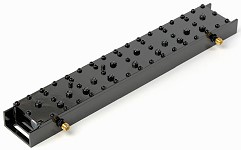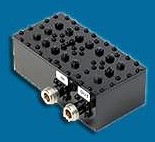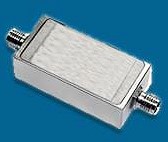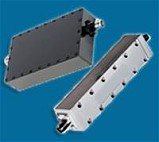Anatech Electronics January 2021 Newsletter |
||

Press Release Archives: 2024 | 2023 | 2022 | 2021 |2020 2019 | 2018 | 2017 | 2016 | 2015 2014 | 2013 | 2012 | 2011 | 2010 2009 | 2008 | 2007 | 2006 | 2005 Content is copyright of company represented. Page format, custom text and images are RF Cafe copyright - do not distribute.
Sam Benzacar of Anatech Electronics, an RF and microwave filter company, has published his January newsletter that features his short op−ed entitled "In a Digital World, Analog Filters Stand Their Ground." It points out that with few exceptions, even the most sophisticated digital RF systems require some form of analog filter at the input (receiver) or output (transmitter). Power levels and aliasing components of sampled systems keep digital (software) filters from being used universally. That bodes well for the world's analog filter companies, including Anatech. Sam also presents some relevant industry news items as well. A Word from Sam Benzacar In a Digital World, Analog Filters Stand Their Ground
As readers of this column surely know, the "digitalization" of electronic systems is inexorably moving toward becoming exclusively digital. That is, any function that can be performed digitally will be because of the many benefits obtained when an analog signal is converted to the digital domain. Some microwave technology has remained an outlier in this respect, either because a function cannot be adequately performed as well digitally or that the operating frequency is higher than what digital technology can address. There is no better example in this respect than the direct RF sampling receiver (Figure 1) that places the analog-to-digital converter (ADC) as near the source of the input signal as possible. This effectively eliminates most of the RF components in the signal path, such as the mixer and local oscillator, because these functions are now performed digitally. The only impediment to using this approach is the limitation of the ADC, whose sampling rate and thus instantaneous bandwidth determines whether a downconverter is necessary to reduce the input frequency to a lower one that can be accommodated by current ADC technology. Direct RF sampling receivers are rapidly replacing the venerable heterodyne architecture (Figure 2) in a wide array of systems, and especially in the software-defined radio (SDR). In fact, the SDR concept inherently uses direct RF sampling as its foundation, after which all functions are performed in the digital domain and configured and reconfigured via software.
We at Anatech Electronics obviously have an affinity for filters: We've been designing and manufacturing them for 30 years and helping thousands of engineers specify and use them effectively. So, we're not surprised that in an increasingly digital world, the filter is still an analog component that in many cases is irreplaceable and will continue to be for many years to come.
A traditional heterodyne receiver consists of a bandpass filter, low-noise amplifier, mixer, and local oscillator.
Budget Glitch Stalls New NOAA AESA Radar
Pandemic Slows IoT Deployments
FCC Funds Broadband Internet Service
RF Switch Technology Advances
Getting Ready for 5G: Anatech Electronics introduce New Ka band 30.5 GHz Waveguide Band Pass Filter. Featuring a center frequency of 30.5 GHz, a bandwidth of 1000 MHz, an Insertion Loss 1 dB Max, and a Power Handling is 20 watts.
Anatech Electronics Introduces a New Line of Suspended Stripline and Waveguide Type RF Filters
Check out Our Filter Products
Cavity Band Pass Filters LC Band Pass Filters Cavity Bandstop/Notch Filter About Anatech Electronics Anatech Electronics, Inc. (AEI) specializes in the design and manufacture of standard and custom RF and microwave filters and other passive components and subsystems employed in commercial, industrial, and aerospace and applications. Products are available from an operating frequency range of 10 kHz to 30 GHz and include cavity, ceramic, crystal, LC, and surface acoustic wave (SAW), as well as power combiners/dividers, duplexers and diplexers, directional couplers, terminations, attenuators, circulators, EMI filters, and lightning arrestors. The company's custom products and capabilities are available at www.anatechelectronics.com. Contact: Anatech Electronics, Inc. 70 Outwater Lane Garfield, NJ 07026 (973) 772-4242
Posted January 28, 2021 |
||

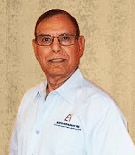 By Sam Benzacar
By Sam Benzacar What's interesting, though, is that while
direct RF sampling erases multiple analog components, two remain: the low-noise
amplifier and the bandpass and anti-aliasing filters.
What's interesting, though, is that while
direct RF sampling erases multiple analog components, two remain: the low-noise
amplifier and the bandpass and anti-aliasing filters.  A direct RF sampling receiver consisting
of only a low-noise amplifier, filters, and the ADC. In some cases, the second
(anti-aliasing) filter is not necessary.
A direct RF sampling receiver consisting
of only a low-noise amplifier, filters, and the ADC. In some cases, the second
(anti-aliasing) filter is not necessary. 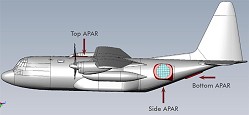 The National Science Foundation has rejected
a National Center for Atmospheric Research (NCAR) plan to design and build it
airborne phased-array radar (APAR) that would support weather operations at
NOAA. The radar would be mounted on aircraft and flown into storms, scanning
hurricanes and other storms in all directions. Compared with the current generation
of Doppler radars mounted on the tails of the NOAA's hurricane hunter P-3 Orion
aircraft, APAR is vastly superior in its ability to gather information. NOAA
had hoped to put the system into its updated fleet of hurricane hunter aircraft
in the next decade. Its aging fleet of P-3 turboprops flew a record 58 missions
in 2020 and are likely to need replacing by 2030. NOAA plans to use C-130 aircraft
for which APAR is being designed.
The National Science Foundation has rejected
a National Center for Atmospheric Research (NCAR) plan to design and build it
airborne phased-array radar (APAR) that would support weather operations at
NOAA. The radar would be mounted on aircraft and flown into storms, scanning
hurricanes and other storms in all directions. Compared with the current generation
of Doppler radars mounted on the tails of the NOAA's hurricane hunter P-3 Orion
aircraft, APAR is vastly superior in its ability to gather information. NOAA
had hoped to put the system into its updated fleet of hurricane hunter aircraft
in the next decade. Its aging fleet of P-3 turboprops flew a record 58 missions
in 2020 and are likely to need replacing by 2030. NOAA plans to use C-130 aircraft
for which APAR is being designed.  A report issued by the research organization
IoT Analytics cited 10 factors that advanced (or hindered IoT development last
year. The analysts found that interest in IoT dropped by 15% from the start
of the pandemic but the markets remain strong. Applications that advanced include
contact tracing, product tracking and verification (including for vaccines),
and enabling touchless technology. The report noted 2021 looks much better,
as the pandemic has accelerated interest in using IoT in healthcare other scenarios.
A report issued by the research organization
IoT Analytics cited 10 factors that advanced (or hindered IoT development last
year. The analysts found that interest in IoT dropped by 15% from the start
of the pandemic but the markets remain strong. Applications that advanced include
contact tracing, product tracking and verification (including for vaccines),
and enabling touchless technology. The report noted 2021 looks much better,
as the pandemic has accelerated interest in using IoT in healthcare other scenarios.
 The FCC late last year awarded $9.2 billion
in funding to help companies provide broadband Internet service to millions
of Americans without access to reliable service. Among the big winners was Elon
Musk's SpaceX, which has been launching dozens of satellites at a time in a
bold attempt to build a massive constellation in space that would help serve
remote or rural areas. The company received $886 million from the FCC to help
serve hundreds of thousands of customers in 35 states, a huge boost in its quest
to pull off a feat even Musk has said had a high likelihood of failure. Other
winners were LTD Broadband, Charter Communications, and the Rural Electric Cooperative
Consortium, each receiving a little over $1 billion.
The FCC late last year awarded $9.2 billion
in funding to help companies provide broadband Internet service to millions
of Americans without access to reliable service. Among the big winners was Elon
Musk's SpaceX, which has been launching dozens of satellites at a time in a
bold attempt to build a massive constellation in space that would help serve
remote or rural areas. The company received $886 million from the FCC to help
serve hundreds of thousands of customers in 35 states, a huge boost in its quest
to pull off a feat even Musk has said had a high likelihood of failure. Other
winners were LTD Broadband, Charter Communications, and the Rural Electric Cooperative
Consortium, each receiving a little over $1 billion. 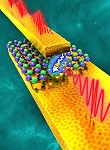 U.S. Army-funded research has developed
an RF switch that is more than 50 times more energy-efficient than current technology.
The Army Combat Capabilities Development Command's Army Research Laboratory,
researchers at The University of Texas at Austin, and the University of Lille
in France, were involved in the research. Its characteristics would benefit
smartphones and other battery-powered devices because unlike typical RF switches
it draws no current when not operational. The technology can transmit an HDTV
stream at 100 GHz and is the first that can function at terahertz frequencies.
The switch is based on the nanomaterial hexagonal boron nitride within the graphene
family. The structure has a single layer of boron and nitrogen atoms in a honeycomb
pattern sandwiched between a pair of gold electrodes.
U.S. Army-funded research has developed
an RF switch that is more than 50 times more energy-efficient than current technology.
The Army Combat Capabilities Development Command's Army Research Laboratory,
researchers at The University of Texas at Austin, and the University of Lille
in France, were involved in the research. Its characteristics would benefit
smartphones and other battery-powered devices because unlike typical RF switches
it draws no current when not operational. The technology can transmit an HDTV
stream at 100 GHz and is the first that can function at terahertz frequencies.
The switch is based on the nanomaterial hexagonal boron nitride within the graphene
family. The structure has a single layer of boron and nitrogen atoms in a honeycomb
pattern sandwiched between a pair of gold electrodes. 
